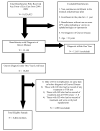Risk factors for developing thyroid-associated ophthalmopathy among individuals with Graves disease
- PMID: 25502604
- PMCID: PMC4495733
- DOI: 10.1001/jamaophthalmol.2014.5103
Risk factors for developing thyroid-associated ophthalmopathy among individuals with Graves disease
Abstract
Importance: Thyroid-associated ophthalmopathy (TAO) is a common and debilitating manifestation of Graves disease (GD). Presently little is known about factors that may increase the risk of developing TAO among patients with GD.
Objective: To identify risk factors associated with the development of TAO among individuals with newly diagnosed GD.
Design, setting, and participants: In this longitudinal cohort study, all beneficiaries 18 years of age or older with newly diagnosed GD who were continuously enrolled in a large nationwide US managed care network and who visited an eye care professional 1 or more times from 2001 to 2009 were identified. International Classification of Diseases, Ninth Revision, Clinical Modification billing codes were used to identify those who developed manifestations of TAO. Multivariable Cox regression was used to determine the hazard of developing TAO among persons with newly diagnosed GD, with adjustment for sociodemographic factors, systemic medical conditions, thyrotropin levels, and medical and surgical interventions for management of hyperthyroidism.
Main outcomes and measures: Manifestations of TAO measured by hazard ratios (HRs) with 95% CIs.
Results: Of 8404 patients with GD who met the inclusion criteria, 740 (8.8%) developed TAO (mean follow-up, 374 days since initial GD diagnosis). After adjustment for potential confounders, surgical thyroidectomy, alone or in combination with medical therapy, was associated with a 74% decreased hazard for TAO (adjusted HR, 0.26 [95% CI, 0.12-0.51]) compared with radioactive iodine therapy alone. Statin use (for ≥60 days in the past year vs <60 days or nonuse) was associated with a 40% decreased hazard (adjusted HR, 0.60 [CI, 0.37-0.93]). No significant association was found for the use of nonstatin cholesterol-lowering medications or cyclooxygenase 2 inhibitors and the development of TAO.
Conclusions and relevance: If prospective studies can confirm our finding that a thyroidectomy and statin use are associated with substantially reduced hazards for TAO among patients with GD, preventive measures for this burdensome manifestation of GD may become a reality.
Conflict of interest statement
The authors have no proprietary interest in any material discussed in this manuscript
None of the authors have any financial disclosures or conflicts of interest to disclose.
Figures
Similar articles
-
Thyroid-associated ophthalmopathy after treatment for Graves' hyperthyroidism with antithyroid drugs or iodine-131.J Clin Endocrinol Metab. 2009 Oct;94(10):3700-7. doi: 10.1210/jc.2009-0747. Epub 2009 Sep 1. J Clin Endocrinol Metab. 2009. PMID: 19723755 Clinical Trial.
-
Management of Graves Thyroidal and Extrathyroidal Disease: An Update.J Clin Endocrinol Metab. 2020 Dec 1;105(12):3704-20. doi: 10.1210/clinem/dgaa646. J Clin Endocrinol Metab. 2020. PMID: 32929476 Free PMC article. Review.
-
Comparative Effectiveness of Treatment Choices for Graves' Hyperthyroidism: A Historical Cohort Study.Thyroid. 2017 Apr;27(4):497-505. doi: 10.1089/thy.2016.0343. Epub 2017 Feb 6. Thyroid. 2017. PMID: 28049375 Free PMC article.
-
Chronology of Graves' ophthalmopathy in an incidence cohort.Am J Ophthalmol. 1996 Apr;121(4):426-34. doi: 10.1016/s0002-9394(14)70439-8. Am J Ophthalmol. 1996. PMID: 8604736
-
2022 Update on Clinical Management of Graves Disease and Thyroid Eye Disease.Endocrinol Metab Clin North Am. 2022 Jun;51(2):287-304. doi: 10.1016/j.ecl.2021.12.004. Epub 2022 May 11. Endocrinol Metab Clin North Am. 2022. PMID: 35662442 Free PMC article. Review.
Cited by
-
The association of race with thyroid eye disease presentation and outcomes.Front Ophthalmol (Lausanne). 2024 Jan 23;3:1309850. doi: 10.3389/fopht.2023.1309850. eCollection 2023. Front Ophthalmol (Lausanne). 2024. PMID: 38983053 Free PMC article.
-
Predictive Factors of Development of Graves' Ophthalmopathy for Patients with Juvenile Graves' Disease.Int J Endocrinol. 2016;2016:8129497. doi: 10.1155/2016/8129497. Epub 2016 Jun 16. Int J Endocrinol. 2016. PMID: 27413373 Free PMC article.
-
The changing landscape of thyroid eye disease: current clinical advances and future outlook.Eye (Lond). 2024 Jun;38(8):1425-1437. doi: 10.1038/s41433-024-02967-9. Epub 2024 Feb 19. Eye (Lond). 2024. PMID: 38374366 Free PMC article. Review.
-
Treatment with bimatoprost for exophthalmos in patients with inactive thyroid-associated ophthalmopathy.Clin Ophthalmol. 2018 Nov 27;12:2415-2421. doi: 10.2147/OPTH.S187164. eCollection 2018. Clin Ophthalmol. 2018. PMID: 30568419 Free PMC article.
-
Epidemiology, Natural History, Risk Factors, and Prevention of Graves' Orbitopathy.Front Endocrinol (Lausanne). 2020 Nov 30;11:615993. doi: 10.3389/fendo.2020.615993. eCollection 2020. Front Endocrinol (Lausanne). 2020. PMID: 33329408 Free PMC article. Review.
References
-
- Vanderpump MPJ, Tunbridge WMG. The epidemiology of thyroid disease. In: Braverman LE, Utiger RD, editors. Werner and Ingbar’s the thyroid: A fundamental and clinical text. 7. Philadelphia, PA: Lippincott-Raven; 1996. pp. 474–482.
-
- Vangheluwe O, Ducasse A, Vaudrey c, Maes B, Delisle MJ. Prevalence of ophthalmopathy in Basedow disease. Follow-up of patients one year following diagnosis of hyperthyroidism. J Fr Ophtalmol. 1994;17:331–8. - PubMed
-
- Bartley GB, Fatourechi V, Kadrmas EF, et al. Long-term follow-up of Graves ophthalmopathy in an incidence cohort. Ophthalmology. 1996;103:958–62. - PubMed
-
- Physician International Classification of Diseases (ICD-9CM) 9th Revision, Clinical Modification. 1 and 2. Chicago, IL: American Medical Association Press; 2006.
Publication types
MeSH terms
Substances
Grants and funding
- K23 EY016339/EY/NEI NIH HHS/United States
- P30 DK092926/DK/NIDDK NIH HHS/United States
- R01 EY021197/EY/NEI NIH HHS/United States
- EY007003/EY/NEI NIH HHS/United States
- EY021197/EY/NEI NIH HHS/United States
- R01 EY011708/EY/NEI NIH HHS/United States
- EY08976/EY/NEI NIH HHS/United States
- EY011708/EY/NEI NIH HHS/United States
- K23 EY019511/EY/NEI NIH HHS/United States
- EY016339/EY/NEI NIH HHS/United States
- 1K23EY019511/EY/NEI NIH HHS/United States
- P30 EY007003/EY/NEI NIH HHS/United States
- F31 EY007003/EY/NEI NIH HHS/United States
- DK063121/DK/NIDDK NIH HHS/United States
- R01 DK063121/DK/NIDDK NIH HHS/United States
- R01 EY008976/EY/NEI NIH HHS/United States
LinkOut - more resources
Full Text Sources
Other Literature Sources
Medical
Research Materials
Miscellaneous


